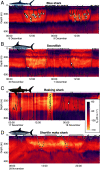Linking vertical movements of large pelagic predators with distribution patterns of biomass in the open ocean
- PMID: 38150462
- PMCID: PMC10666118
- DOI: 10.1073/pnas.2306357120
Linking vertical movements of large pelagic predators with distribution patterns of biomass in the open ocean
Abstract
Many predator species make regular excursions from near-surface waters to the twilight (200 to 1,000 m) and midnight (1,000 to 3,000 m) zones of the deep pelagic ocean. While the occurrence of significant vertical movements into the deep ocean has evolved independently across taxonomic groups, the functional role(s) and ecological significance of these movements remain poorly understood. Here, we integrate results from satellite tagging efforts with model predictions of deep prey layers in the North Atlantic Ocean to determine whether prey distributions are correlated with vertical habitat use across 12 species of predators. Using 3D movement data for 344 individuals who traversed nearly 1.5 million km of pelagic ocean in [Formula: see text]42,000 d, we found that nearly every tagged predator frequented the twilight zone and many made regular trips to the midnight zone. Using a predictive model, we found clear alignment of predator depth use with the expected location of deep pelagic prey for at least half of the predator species. We compared high-resolution predator data with shipboard acoustics and selected representative matches that highlight the opportunities and challenges in the analysis and synthesis of these data. While not all observed behavior was consistent with estimated prey availability at depth, our results suggest that deep pelagic biomass likely has high ecological value for a suite of commercially important predators in the open ocean. Careful consideration of the disruption to ecosystem services provided by pelagic food webs is needed before the potential costs and benefits of proceeding with extractive activities in the deep ocean can be evaluated.
Keywords: bio-logging; bioacoustics; deep ocean; marine megafauna; movement ecology.
Conflict of interest statement
The authors declare no competing interest.
Figures




Similar articles
-
Mesoscale eddies release pelagic sharks from thermal constraints to foraging in the ocean twilight zone.Proc Natl Acad Sci U S A. 2019 Aug 27;116(35):17187-17192. doi: 10.1073/pnas.1903067116. Epub 2019 Aug 6. Proc Natl Acad Sci U S A. 2019. PMID: 31387979 Free PMC article.
-
Prey patch patterns predict habitat use by top marine predators with diverse foraging strategies.PLoS One. 2013;8(1):e53348. doi: 10.1371/journal.pone.0053348. Epub 2013 Jan 3. PLoS One. 2013. PMID: 23301063 Free PMC article.
-
The Functional and Ecological Significance of Deep Diving by Large Marine Predators.Ann Rev Mar Sci. 2022 Jan 3;14:129-159. doi: 10.1146/annurev-marine-032521-103517. Epub 2021 Aug 20. Ann Rev Mar Sci. 2022. PMID: 34416123
-
Cascading top-down effects of changing oceanic predator abundances.J Anim Ecol. 2009 Jul;78(4):699-714. doi: 10.1111/j.1365-2656.2009.01531.x. Epub 2009 Mar 9. J Anim Ecol. 2009. PMID: 19298616 Review.
-
Diet Composition and Trophic Ecology of Northeast Pacific Ocean Sharks.Adv Mar Biol. 2017;77:111-148. doi: 10.1016/bs.amb.2017.06.001. Epub 2017 Aug 18. Adv Mar Biol. 2017. PMID: 28882212 Review.
Cited by
-
Climate-driven global redistribution of an ocean giant predicts increased threat from shipping.Nat Clim Chang. 2024;14(12):1282-1291. doi: 10.1038/s41558-024-02129-5. Epub 2024 Oct 7. Nat Clim Chang. 2024. PMID: 39650805 Free PMC article.
-
Unlocking sea turtle diving behaviour from low-temporal resolution time-depth recorders.Sci Rep. 2025 Jun 6;15(1):19934. doi: 10.1038/s41598-025-05336-y. Sci Rep. 2025. PMID: 40481176 Free PMC article.
-
Seasonal habitat use and diel vertical migration in female spurdog in Nordic waters.Mov Ecol. 2024 Sep 6;12(1):62. doi: 10.1186/s40462-024-00498-2. Mov Ecol. 2024. PMID: 39242541 Free PMC article.
-
Annual migrations, vertical habitat use and fidelity of Atlantic bluefin tuna tracked from waters off the United Kingdom.Sci Rep. 2025 Jan 2;15(1):293. doi: 10.1038/s41598-024-80861-w. Sci Rep. 2025. PMID: 39747925 Free PMC article.
References
-
- Sutton T. T., Vertical ecology of the pelagic ocean: Classical patterns and new perspectives. J. Fish Biol. 83, 1508–1527 (2013). - PubMed
-
- P. Hoagland et al., Value beyond view: Illuminating the human benefits of the ocean twilight zone (Woods Hole Oceanographic Institution, 2019). https://www.google.com/url?sa=t&rct=j&q=&esrc=s&source=web&cd=&cad=rja&u....
MeSH terms
LinkOut - more resources
Full Text Sources

